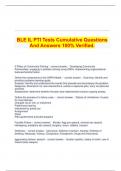BLE IL PTI Tests Cumulative Questions
And Answers 100% Verified.
3 Pillars of Community Policing - correct answer. Developing Community
Partnerships, engaging in problem solving using SARA, Implementing organizational
features/transformation.
Define the components of the SARA Model. - correct answer. Scanning- identify and
prioritize problems develop goals.
Analysis- identify and understand the events that precede and accompany the problem.
Response- Brainstorm for new interventions, outline a response plan, carry out planned
activities.
Assessment- determine whether the plan was implemented conduct ongoing assess.
Outline the process of a felony case. - correct answer. Statute of Limitations= 3 years
for most felonies
Charged via an info. or indictment
Preliminary hearing
Indictment by grand jury
Arraignment
Pleas
Plea agreements and plea bargains
Forcible Felony - correct answer. Murder, Agg sex assault, criminal sex assault,
kidnapping, predatory sex assault, burglary, arson, robbery, treason.
Defenses - correct answer. Ignorance, Defense of person, Insanity, Defense of
dwelling, Necessity, Infancy, Compulsion, Entrapment, Drugs and Intoxicants.
aggravating factors- assault - correct answer. location (public), status of victim, use of
firearm/other weapon.
,Predatory Criminal Sexual Assault of a Child - correct answer. Accused is 17 or over
and victim is under 13
Class X Felony (6-60 years)
If convicted of two or more, natural life in prison
Sexual Conduct - correct answer. any knowing, touching, or fondling by the victim of
the accused, either directly or through clothing.
Criminal Sexual Assault - correct answer. the act of sexual penetration and the use of
force or threat of force.
act of sexual penetration and the accused knew the victim is unable to give knowing
consent.
act of penetration and victim is under 18 and the accused is family.
age 13-17 victim or accused is 17 or over but the person is authority or family.
Defenses to Criminal Sexual Assault/Abuse - correct answer. consensual
lack of verbal or physical resistance
Theft (Misdemeanor/Felony) - correct answer. over $500- felony
less than $500= misdemeanor
Retail Theft (Misdemeanor/Felony) - correct answer. greater than $300= Felony
Less than $300= misdemeanor
Deceptive Practice (Misdemeanor/Felony) - correct answer. greater than $150= felony
Less than $150= misdemeanor
Criminal Damage to Property - correct answer. Greater than $500= Felony
Less than $500= Misdemeanor
Weeks vs. US - correct answer. Exclusionary rule at federal level- 1914
Gideon v. Wainwright - correct answer. A person who cannot afford an attorney may
have one appointed by the government. 1963
Graham v. Connor - correct answer. objective reasonableness. 1989
Mapp v. Ohio (1961) - correct answer. Extended the Exclusionary Rule to the states,
increasing the protections for defendants
Tennessee v. Garner (1985) - correct answer. Deadly force may not be used against
an unarmed and fleeing suspect unless necessary to prevent the escape and unless the
officer has probable cause to believe that the suspect poses a significant threat of death
or serious injury to the officers or others.
, Terry v. Ohio (1968) - correct answer. Police can detain a suspect with reasonable
suspicion that they have committed, are committing, or are about to commit a crime.
Miranda v. Arizona - correct answer. Supreme Court held that criminal suspects must
be informed of their right to consult with an attorney and of their right against self-
incrimination prior to questioning by police. 1966
Brady v. Maryland - correct answer. Prosecution must provide all evidence even if it
helps the defense.
Criminal Sexual Abuse - correct answer. act of sexual conduct and use or threat of
force. OR act of sexual conduct and accused knew victim was unable to understand the
nature of the act. OR an act of penetration and the accused is 16 or younger.
Forcible Felony - correct answer. Murder, agg sex assault, criminal sex assault,
kidnapping, predatory sex assault, burglary, arson, robbery, treason.
Bio criminology - correct answer. research into the roles played by genetic and
neurophysiological variables in criminal behavior
Routine Activity Theory - correct answer. a perspective on adolescence that views
unstructured, unsupervised time with peers as a main cause of misbehavior
Rationale Choice Theory - correct answer. states that individuals will make decisions
that maximize potential benefit and minimize potential harm
Classical School of Criminology - correct answer. A set of criminological theories that
uses the idea of free will to explain criminal behavior.
deterrance theory - correct answer. philosophy of criminal justice arising from the
notion that crime results from a rational calculation of its costs and benefits
Amendments impacting criminal procedure - correct answer. 4th- unwarranted search
and seizure
5th- no need to answer to incriminate yourself, also prohibits double jeopardy.
6th- right to speedy and public trial
8th- No excessive bail and prohibits cruel and unusual punishment
10th- reserved powers clause
14th- due process
Assault - correct answer. without lawful authority, engages in conduct which places
another in reasonable apprehension of receiving a battery.
Battery - correct answer. knowingly, without legal justification, and by any means
causes bodily harm or makes physical contact of an insulting and provoking nature with
an individual.




